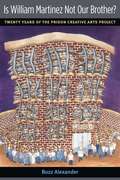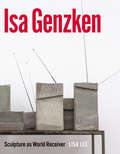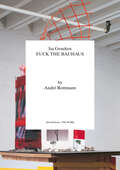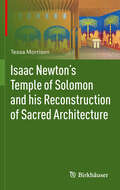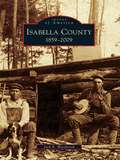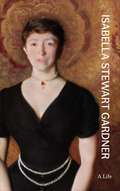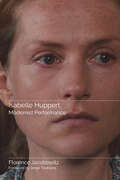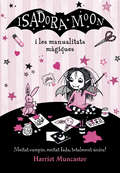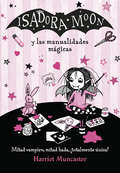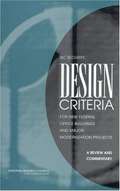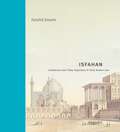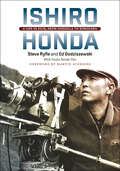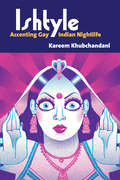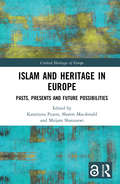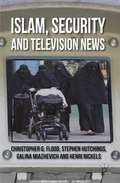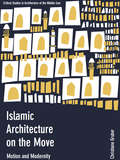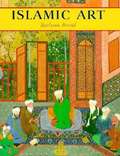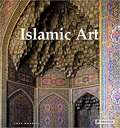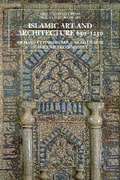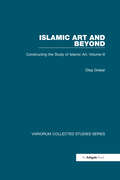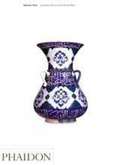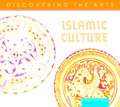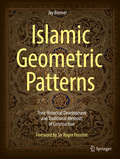- Table View
- List View
Is This Live?: The Nation's Music Station
by Christopher Ward Mike MyersFrom former VJ Christopher Ward, Is This Live? captures the pure fun and rock 'n' roll rebellion of the early years of MuchMusic. On August 31, 1984, the Nation's Music Station launched, breaking ground as the Wild (Canadian) West of television--live, gloriously unpredictable, seat-of-the-pants TV, delivered fresh daily. The dream child of TV visionary Moses Znaimer, and John Martin, the maverick creator of The New Music, Much was live and largely improvised, and an entire generation of Canadians grew up watching the VJs and embraced the new music that became the video soundtrack of our lives. The careers of Canadian legends like Blue Rodeo, Corey Hart, Jane Siberry, Bryan Adams, Platinum Blonde, Glass Tiger, Colin James, the Parachute Club, Honeymoon Suite, Barenaked Ladies, Maestro Fresh Wes and Sloan were launched when Much brought them closer to their fans. Much also gave us international acts (Duran, Duran, Tina Turner, Iggy Pop, David Bowie, Madonna, Motorhead, Guns N' Roses, Nirvana, Red Hot Chili Peppers), and covered the second wave of music activism with events like Live Aid and the Amnesty International Human Rights Now! tour. Ranging from Toronto's iconic studio at 299 Queen Street West, to Vancouver's MuchWest, MuchMusic's programming travelled across Canada and connected the Canadian music scenes in an unprecedented way. With stories of the bands, the music, the videos, the specialty shows, the style and the improvisational approach to daily broadcast life at Much, Is This Live? is told by the people who were there--the colourful cast of on-air VJs, the artists who found their way into our living rooms of the nation as never before, and the people behind the cameras. As our tour guide to the first decade at MuchMusic Christopher Ward delivers a full-on dose of pop culture nostalgia from the 1980s and '90s, when the music scene in Canada changed forever.From the Trade Paperback edition.
Is William Martinez Not Our Brother?: Twenty Years of the Prison Creative Arts Project
by Buzz AlexanderA prison arts program attempts to reverse the trends of incarceration in America
Isa Genzken: Sculpture as World Receiver
by Lisa LeeThe work of German sculptor Isa Genzken is brilliantly receptive to the ever-shifting conditions of modern life. In this first book devoted to the artist, Lisa Lee reflects on Genzken’s tendency to think across media, attending to sculptures, photographs, drawings, and films from the entire span of her four-decade career, from student projects in the mid-1970s to recent works seen in Genzken’s studio. Through penetrating analyses of individual works as well as archival and interview material from the artist herself, Lee establishes four major themes in Genzken’s oeuvre: embodied perception, architecture and built space, the commodity, and the body. Contextualizing the sculptor’s engagement with fellow artists, such as Joseph Beuys and Bruce Nauman, Lee situates Genzken within a critical and historical framework that begins in politically fraught 1960s West Germany and extends to the globalized present. Here we see how Genzken tests the relevance of the utopian aspirations and formal innovations of the early twentieth century by submitting them to homage and travesty. Sure to set the standard for future studies of Genzken’s work, Isa Genzken is essential for anyone interested in contemporary art.
Isa Genzken: Fuck the Bauhaus (Afterall Books / One Work)
by Andre RottmanA strikingly original analysis of Isa Genzken&’s move towards merging sculptural and architectural morphologies into a trailblazing practice of contemporary assemblage.Fuck the Bauhaus, a series of audacious architectural models for future high-rise buildings in Manhattan, marks a poetic and provocative shift in Isa Genzken&’s artistic oeuvre. Made in the year 2000, out of quotidian objects and cheap materials foraged in the streets and stores of New York, these sculptural assemblages depart from the German artist&’s &‘post-Minimalist&’ works begun in the 1970s. The earlier works conjured the haunting spectres of catastrophe, destruction and failed utopia, as well as the potential for freedom amidst the ruins of post-War reconstruction culture.Analysing Genken&’s post–2000 penchant for appropriation, collage and montage, André Rottmann draws on the writings of Deleuze and Guattari, Bruno Latour and other theorists of "assemblage," to show how her &‘late style&’ is not a return to (neo-)avant-garde traditions but a powerful reimagining of them for the contemporary moment.
Isaac Newton's Temple of Solomon and his Reconstruction of Sacred Architecture
by Tessa MorrisonThis book is about a side of Isaac Newton's character that has not been examined - Isaac Newton as architect as demonstrated by his reconstruction of Solomon's Temple. Although it is well known that Isaac Newton worked on the Temple, and this is mentioned in most of his biographies and in articles on the religious aspects of this work, however, there is no research on Newton's architectural work. This book not only recreates Newton's reconstruction of the Temple but it also considers how his work on the Temple interlinks with his other interests of science, chronology, prophecy and theology. In addition the book contains the first translation of Introduction to the Lexicon of the Prophets, Part two: About the appearance of the Jewish Temple commonly known by its call name Babson 0434. This work will appeal not only to scholars of science and architectural history but also to scholars of the seventeenth and eighteenth centuries' history of ideas.
Isabella County: 1859 - 2009 (Images of America)
by Jack R. WestbrookAn ancient revered gathering and hunting place for Chippewa Indians becomes the modern home to one of the nation's largest Native American tribal-owned casino/resort complexes. A rough-and-tumble timbering center sees Michigan's first lumber millionaire plat a town, dedicating five acres for a county seat. Residents organize a private normal school for teacher training, to become Michigan's fourth-largest university, Central Michigan University. Hardworking immigrants carve farms, villages, and towns from the timbered-out wilderness near the center of the Michigan Lower Peninsula "mitten." From harvesting lumber above the ground to harvesting petroleum below the ground, the area ushers in an oil boom on time to be saved from the financial tribulations of the Great Depression. Incorporated in 1859, during the turbulent times just ahead of the Civil War and birth year of the United States oil industry, the area becomes a modern-day commerce center. This is the saga of Isabella County, told as the county celebrates 150 years of economic and cultural diversity.
Isabella Stewart Gardner: A Life
by Nathaniel Silver Diana Seave GreenwaldA major new biography of legendary art collector and philanthropist Isabella Stewart GardnerIsabella Stewart Gardner (1840–1924) assembled an extraordinary collection of art from diverse cultures and eras—and built a Venetian-style palazzo in Boston to share these exquisite treasures with the world. But her life and work remains shrouded in myth. Separating fiction and fact, this book paints an unforgettable portrait of Gardner, drawing on her substantial personal archive and including previously unpublished findings to offer new perspectives on her life and her construction of identity.Nathaniel Silver and Diana Seave Greenwald shed new light on Gardner's connections to minority communities in Boston, her views on suffrage and other issues of the day, the sources of her and her husband’s wealth, and her ties to politicians, writers, and artists. What emerges is a multifaceted portrait of a trailblazing collector and patron of the arts—from Italian Renaissance paintings to Chinese antiquities—who built a museum unprecedented in its curatorial vision.Beautifully illustrated, this book challenges any portrayal of Gardner as a straightforward feminist hero, revealing instead an exceptional, complex woman who created a legendary museum and played a vibrant and influential role in the art world.Distributed for the Isabella Stewart Gardner Museum
Isabelle Huppert, Modernist Performance
by Florence JacobowitzIsabelle Huppert's modernist performance style illustrated through detailed readings of key films, demonstrating her immense social impact. Isabelle Huppert's oeuvre constitutes perhaps the most significant feminist body of work to have emerged in the wake of the second wave of the women's movement, a period of intense social change. The emphasis on autonomy, or the "anti-victim," which comes to define Huppert's persona, is supported by a modernist style of performance. Huppert's refusal to surrender herself to the viewer through a character one fully knows disrupts the expectations of identification, inviting a distinctive approach to her characters. By creating a character informed by who she is, Huppert signals a process usually kept invisible. Huppert's performances invite an active form of critical reading, directing one to fill in gaps and consider the character in relation to the social world. The directors she works with welcome her collaboration; Huppert's performance, in conjunction with the mise-en-scène, generic conventions, and the film in its totality, creates the "meaning" of the film. Thus, Isabelle Huppert, Modernist Performance demonstrates its premise through close readings considering how performance must be read in tandem with the whole.
Isadora Moon i les manualitats màgiques (La Isadora Moon #Volumen)
by Harriet MuncasterEl llibre de manualitats de la Isadora Moon! La Isadora Moon és especial perquè és diferent. Vols ser com ella? Amb aquest llibre de manualitats podràs transformar-te en una fada o en un vampir i crear els accessoris més magnífics i increïbles. Dissenya i crea la teva pròpia vareta màgica, el teu diari de vampir, una esgarrifosa invitació d'aniversari o al teu propi rat-penat mascota.
Isadora Moon y las manualidades mágicas (Isadora Moon #Volumen)
by Harriet Muncaster¡El libro de manualidades de Isadora Moon! Isadora Moon es especial porque es diferente. ¿Quieres ser como ella? Con este libro de manualidades podrás transformarte en hada o en vampiro y crear los accesorios más mágicos e increíbles. Diseña tu propia varita mágica, tu diario de vampiro, una espeluznante invitación de cumpleaños o a tu propio murciélago-mascota.
Isc Security Design Criteria For New Federal Office Buildings And Major Modernization Projects: A Review And Commentary
by Committee to Review the Security Design Criteria of the Interagency Security CommitteeInformation on the Isc Security Design Criteria For New Federal Office Buildings And Major Modernization Projects
Isfahan: Architecture and Urban Experience in Early Modern Iran (Buildings, Landscapes, and Societies)
by Farshid EmamiA vibrant urban settlement from medieval times and the royal seat of the Safavid dynasty, the city of Isfahan emerged as a great metropolis during the seventeenth century. Using key sources, this book reconstructs the spaces and senses of this dynamic city.Focusing on nuances of urban experience, Farshid Emami expands our understanding of Isfahan in a global context. He takes the reader on an evocative journey through the city’s markets, promenades, and coffeehouses, bringing to life the social landscapes that animated the lives of urban dwellers and shaped their perceptions of themselves and the world. In doing so, Emami reveals seventeenth-century Isfahan as more than a cluster of beautiful monuments and gardens. It was a cosmopolitan city, where senses and materials, nature and artifice, and ritual and sociability acted in unison, engendering urban experiences that became paramount across the globe during the early modern period.Drawing extensively on Persian literary and visual sources, including the “Guide for Strolling in Isfahan,” this book casts new light on the history of a major Eurasian city and opens up new possibilities for cross-cultural studies of urban experience in the early modern period.
Ishiro Honda: A Life in Film, from Godzilla to Kurosawa
by Martin Scorsese Steve Ryfle Ed Godziszewski Yuuko Honda-YunIshiro Honda was arguably the most internationally successful Japanese director of his generation, with an unmatched succession of science fiction films that were commercial hits worldwide. From the atomic allegory of Godzilla and the beguiling charms of Mothra to the tragic mystery of Matango and the disaster and spectacle of Rodan, The Mysterians, King Kong vs. Godzilla, and many others, Honda’s films reflected postwar Japan’s real-life anxieties and incorporated fantastical special effects, a formula that appealed to audiences around the globe and created a popular culture phenomenon that spans generations. Now, in the first full account of this long overlooked director’s life and career, authors Steve Ryfle and Ed Godziszewski shed new light on Honda’s work and the experiences that shaped it—including his days as a reluctant Japanese soldier, witnessing the aftermath of Hiroshima, and his lifelong friendship with Akira Kurosawa. Ishiro Honda: A Life in Film, from Godzilla to Kurosawa features close analysis of Honda’s films (including, for the first time, his rarely seen dramas, comedies, and war films) and draws on previously untapped documents and interviews to explore how creative, economic, and industrial factors impacted his career. Fans of Honda, Godzilla, and tokusatsu (special effects) film, and of Japanese film in general, will welcome this in-depth study of a highly influential director who occupies a uniquely important position in science fiction and fantasy cinema, as well as in world cinema. Together, the authors have provided audio commentary tracks and produced supplemental material for numerous home video releases, including Ishiro Honda’s Godzilla for the British Film Institute. They co-produced the documentary feature Bringing Godzilla Down to Size (2008).
Ishtyle: Accenting Gay Indian Nightlife (Triangulations: Lesbian/Gay/Queer Theater/Drama/Performance)
by Kareem KhubchandaniIshtyle follows queer South Asian men across borders into gay neighborhoods, nightclubs, bars, and house parties in Bangalore and Chicago. Bringing the cultural practices they are most familiar with into these spaces, these men accent the aesthetics of nightlife cultures through performance. Kareem Khubchandani develops the notion of “ishtyle” to name this accented style, while also showing how brown bodies inadvertently become accents themselves, ornamental inclusions in the racialized grammar of desire. Ishtyle allows us to reimagine a global class perpetually represented as docile and desexualized workers caught in the web of global capitalism. The book highlights a different kind of labor, the embodied work these men do to feel queer and sexy together. Engaging major themes in queer studies, Khubchandani explains how his interlocutors’ performances stage relationships between: colonial law and public sexuality; film divas and queer fans; and race, caste, and desire. Ultimately, the book demonstrates that the unlikely site of nightlife can be a productive venue for the study of global politics and its institutional hierarchies.
Islam and Heritage in Europe: Pasts, Presents and Future Possibilities (Critical Heritages of Europe)
by Katarzyna Puzon Sharon Macdonald Mirjam ShatanawiIslam and Heritage in Europe provides a critical investigation of the role of Islam in Europe’s heritage. Focusing on Islam, heritage and Europe, it seeks to productively trouble all of these terms and throw new light on the relationships between them in various urban, national and transnational contexts. Bringing together international scholars from a range of disciplines, this collection examines heritage-making and Islam in the context of current events in Europe, as well as analysing past developments and future possibilities. Presenting work based on ethnographic, historical and archival research, chapters are concerned with questions of diversity, mobility, decolonisation, translocality, restitution and belonging. By looking at diverse trajectories of people and things, this volume encompasses multiple perspectives on the relationship between Islam and heritage in Europe, including the ways in which it has played out and transformed against the backdrop of the ‘refugee crisis’ and other recent developments, such as debates on decolonising museums or the resurgence of nationalist sentiments. Islam and Heritage in Europe discusses specific articulations of belonging and non-belonging, and the ways in which they create new avenues for re-thinking Islam and heritage in Europe. This ensures that the book will be of interest to academics, researchers and postgraduate students engaged in the study of heritage, museums, Islam, Europe, anthropology, archaeology and art history.
Islam, Security and Television News
by Christopher Flood Stephen Hutchings Galina Miazhevich Henri C. NickelsFocusing on British, French and Russian television news coverage of Islam as a security threat, this book provides the first comparative account of how television broadcasting in different geo- and socio-political environments integrates discourses on Islam into nationally oriented, representational systems.
Islamic Architecture on the Move: Motion And Modernity
by Christiane GruberEven a casual observer can spy traces of Islamic architecture and design on buildings all over the world, a reminder that artistic traditions and visual culture have never been limited to their region or country of origin, but rather are highly diffusible. <P><P> This book brings together scholars from architectural studies, design, art history, and other fields to challenge and expand concepts of Islamic architecture. Ranging from eighteenth-century Ottoman tents to manifestations of Islamic motifs in 1960s Hawaii, this richly illustrated volume raises key questions about Islamic architecture, and, more broadly, about how we can rethink our understanding of material, artistic, and cultural mobility in the modern world.
Islamic Art
by Barbara BrendFrom the Alhambra to the Taj Mahal, from the Dome of the Rock to the ever evolving art of calligraphy, Barbara Brend traces the development of classic Islamic art from the seventh through the twentieth century. Brend narrates this history region by region, illustrating her discussion with superb examples drawn from all areas in which Muslim artists and craftsmen have excelled--mosque and palace architecture; the art of the book (calligraphy, painting, and bindings); and the decorative arts, including metalwork, carvings, mosaics, pottery, textiles, and carpets. Throughout, the author elucidates forms, aesthetic principles, themes, and imagery. And she points to sources and influences in the different periods--for example, the prominence of jade and chinoiserie after the Mongol invasion.
Islamic Art: Architecture, Painting, Calligraphy, Ceramics, Glass, Carpets
by Luca MozzatiFrom its birth in the seventh century through modern times, the Islamic religion has inspired glorious works of art. This stunning book includes more than four hundred reproductions of treasures of Islamic art that span the world: from southern Europe, along the entire Mediterranean basin to sub-Saharan Africa through the Middle East, India, and Central Asia. Arranged geographically, the objects include paintings, miniatures, ceramics, calligraphy, textiles, carpets, and metal works. Each region is given a thorough introduction that offers historical context and extensive descriptions of its artifacts. Accompanying essays offer guidance in interpreting the many themes that tie these works together, including typology, calligraphy, and religious beliefs. Despite its wide-ranging history and origins, Islamic art is unified by its devotion to faith and beauty. With its large format, exquisite reproductions, and extensive research, this book is a thorough introduction to the Islamic artistic tradition.
Islamic Art and Architecture: 650-1250
by Richard Ettinghausen Oleg Grabar Marilyn Jenkins-Madina"This illustrated book provides an overview of Islamic art and architecture from the seventh to the thirteenth centuries, a time of the formation of a new artistic culture and its first, medieval, flowering in the vast area from the Atlantic to India. Inspired by Ettinghausen and Grabar's original text, this book has been completely rewritten and updated to take into account recent information and methodological advances. "--BOOK JACKET. Title Summary field provided by Blackwell North America, Inc. All Rights Reserved
Islamic Art and Beyond: Constructing the Study of Islamic Art, Volume III (Variorum Collected Studies)
by Oleg GrabarIslamic Art and Beyond is the third in a set of four volumes of studies on Islamic art by Oleg Grabar. Between them they bring together more than eighty articles, studies and essays, work spanning half a century by a master of the field. Each volume takes a particular section of the topic, the three other volumes being entitled: Early Islamic Art, 650-1100; Islamic Visual Culture, 1100-1800; and Jerusalem. Reflecting the many incidents of a long academic life, they illustrate one scholar's attempt at making order and sense of 1400 years of artistic growth. They deal with architecture, painting, objects, iconography, theories of art, aesthetics and ornament, and they seek to integrate our knowledge of Islamic art with Islamic culture and history as well as with the global concerns of the History of Art. In addition to the articles selected, each volume contains an introduction which describes, often in highly personal ways, the context in which Grabar's scholarship developed and the people who directed and mentored his efforts. The articles in the present volume illustrate how the author's study of Islamic art led him in two directions for a further understanding of the arts. One is how to define Islamic art and what impulses provided it with its own peculiar forms and dynamics of growth. Was it a faith or a combination of social, historical, and cultural events? And how has 'Islamic art' impacted on the contemporary arts of the Islamic world? The other issue is that of the meanings to be given to forms like domes, so characteristic of Islamic art, or to terms like symbol, signs, or aesthetic values in the arts, especially when one considers the contemporary world. The Islamic examples allow for the development of new intellectual positions for the history and criticism of the arts everywhere.
Islamic Arts
by Jonathan Bloom Sheila S. BlairA comprehensive survey that brilliantly captures the essence of Islamic culture. Islamic Arts, a comprehensive survey covering a thousand years, highlights those characteristics that connect the various arts of the Islamic lands without minimizing the differences. The book is divided into three time periods - 600-900, 900-1500 and 1500-1800 - and each section analyses architecture, the arts of the book, decorative and applied arts. Islamic Artsbrilliantly captures the essence of Islamic culture.
Islamic Culture (Discovering the Arts)
by Atif ToorThis book describes Islamic art, from the building of the Dome of the Rock in Jerusalem in 691 to the work of Pakistani artist Shahzia Sikander, who expresses modern ideas in her miniature paintings.
Islamic Gardens and Landscapes (Penn Studies in Landscape Architecture)
by D. Fairchild Ruggles"In the course of my research," writes D. Fairchild Ruggles, "I devoured Arabic agricultural manuals from the tenth through the fourteenth centuries. I love gardening, and in these texts I was able to enter the minds of agriculturalists and botanists of a thousand years ago who likewise believed it was important and interesting to record all the known ways of propagating olive trees, the various uses of rosemary, and how best to fertilize a garden bed."Western admirers have long seen the Islamic garden as an earthly reflection of the paradise said to await the faithful. However, such simplification, Ruggles contends, denies the sophistication and diversity of the art form. Islamic Gardens and Landscapes immerses the reader in the world of the architects of the great gardens of the Islamic world, from medieval Morocco to contemporary India.Just as Islamic culture is historically dense, sophisticated, and complex, so too is the history of its built landscapes. Islamic gardens began from the practical need to organize the surrounding space of human civilization, tame nature, enhance the earth's yield, and create a legible map on which to distribute natural resources. Ruggles follows the evolution of these early farming efforts to their aristocratic apex in famous formal gardens of the Alhambra in Spain and the Taj Mahal in Agra.Whether in a humble city home or a royal courtyard, the garden has several defining characteristics, which Ruggles discusses. Most notable is an enclosed space divided into four equal parts surrounding a central design element. The traditional Islamic garden is inwardly focused, usually surrounded by buildings or in the form of a courtyard. Water provides a counterpoint to the portioned green sections.Ranging across poetry, court documents, agronomy manuals, and early garden representations, and richly illustrated with pictures and site plans, Islamic Gardens and Landscapes is a book of impressive scope sure to interest scholars and enthusiasts alike.
Islamic Geometric Patterns
by Jay BonnerThe main focus of this unique book is an in-depth examination of the polygonal technique; the primary method used by master artists of the past in creating Islamic geometric patterns. The author details the design methodology responsible for this all-but-lost art form and presents evidence for its use from the historical record, both of which are vital contributions to the understanding of this ornamental tradition. Additionally, the author examines the historical development of Islamic geometric patterns, the significance of geometric design within the broader context of Islamic ornament as a whole, the formative role that geometry plays throughout the Islamic ornamental arts (including calligraphy, the floral idiom, dome decoration, geometric patterns, and more), and the underexamined question of pattern classification. Featuring over 600 beautiful color images, Islamic Geometric Patterns: Their Historical Development and Traditional Methods of Con struction is a valuable addition to the literature of Islamic art, architecture and geometric patterns. This book is ideal for students and scholars of geometry, the history of mathematics, and the history of Islamic art, architecture, and culture. In addition, artists, designers, craftspeople, and architects will all find this book an exceptionally informative and useful asset in their fields. Jay Bonner is an architectural ornamentalist and unaffiliated scholar of Islamic geometric design. He received his MDes from the Royal College of Art in London (1983). He has contributed ornamental designs for many international architectural projects, including the expansion of both the al-Masjid al-Haram (Grand Mosque) in Mecca, and the al-Masjid an Nawabi (Prophet's Mosque) in Medina, as well the Tomb of Sheikh Hujwiri in Lahore, and the Ismaili Centre in London - to name but a few. He is committed to the revitalization of Islamic geometric design through the teaching of traditional methodological practices. To this end, in addition to publishing, Jay Bonner has lectured and taught design seminars at many universities and conferences in North America, Europe, North Africa and Asia.

